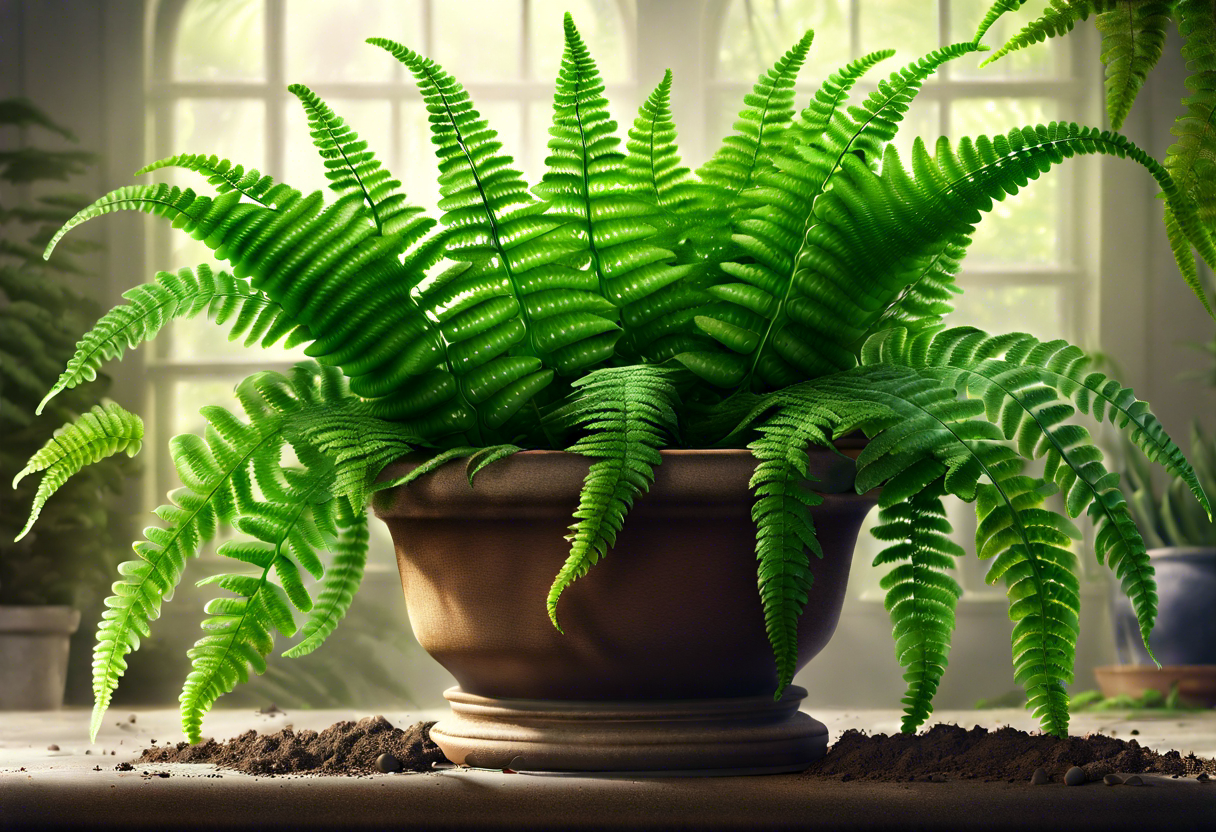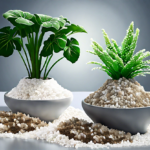Choosing the Right Soil or Potting Mix for Boston Fern (Nephrolepis exaltata)
When it comes to caring for your Boston Fern (Nephrolepis exaltata), one of the most important factors to consider is the type of soil or potting mix you use. The proper soil will provide essential nutrients, promote healthy growth, and ensure the overall well-being of your fern.
The best soil or potting mix for Boston Fern is one that is loose, well-draining, and rich in organic matter. This type of soil mimics the fern’s natural habitat, which is typically moist, humid, and shaded. A well-draining soil is crucial to prevent waterlogged roots, which can lead to root rot.
When selecting a potting mix for your Boston Fern, it is essential to avoid heavy soils or those that can compact easily, as this can hinder proper drainage and aeration. Look for potting mixes specifically formulated for ferns or houseplants, as these will often have the right ratio of organic matter and drainage materials.
One common mistake to avoid is using garden soil directly in pots or containers. Garden soil is typically too heavy and can become compacted, leading to poor drainage and suffocating the roots. It may also contain pests, diseases, or weed seeds that can harm the fern.
Instead, consider creating your own potting mix for your Boston Fern. A simple recipe involves combining equal parts peat moss, perlite or vermiculite, and organic compost. The peat moss provides moisture retention, while the perlite or vermiculite adds drainage and aeration. The organic compost enriches the soil with nutrients.
Another option is to purchase a pre-mixed potting soil specifically labeled for ferns or houseplants. These mixes are often formulated with components like sphagnum moss, bark chips, and coconut coir, which all promote proper drainage and moisture retention.
Keeping the soil moisture level in check is crucial for the health of your Boston Fern. These plants prefer consistently moist soil but can’t tolerate being waterlogged. To maintain the ideal moisture level, water the fern when the top inch of the soil feels dry to the touch. It’s essential to ensure proper drainage by choosing pots with drainage holes and using a well-draining potting mix.
Choosing the right soil or potting mix for your Boston Fern is essential for its overall health and well-being. Opt for loose, well-draining soil or a quality potting mix specifically formulated for ferns or houseplants. Avoid using heavy garden soil, as this can lead to root rot and other issues. Consider creating your own potting mix or purchasing a pre-mixed fern soil. Remember to maintain proper soil moisture by watering when the top inch of the soil feels dry. By providing the right soil conditions, you can enjoy a thriving and beautiful Boston Fern in your home or garden.
The Best Soil or Potting Mix for Boston Fern (Nephrolepis exaltata)
When it comes to Boston Fern (Nephrolepis exaltata), choosing the right soil or potting mix is crucial for its overall health and growth. The quality of the soil directly impacts the fern’s nutrient uptake, water retention, and root development. In this article, we will discuss the characteristics of the best soil or potting mix for Boston Fern to help you provide the optimal growing conditions for this popular houseplant.
The ideal soil or potting mix for Boston Fern should be well-draining to prevent waterlogged conditions that can lead to root rot. Sandy loam or peat-based mixes are excellent choices as they allow excess water to drain away while retaining enough moisture for the fern’s hydration needs. These mixes also ensure adequate aeration, facilitating root respiration and preventing the soil from becoming compacted.
In addition to good drainage, the soil should also retain enough moisture to keep the Boston Fern hydrated. Therefore, it’s important to incorporate organic matter into the potting mix. Organic matter, such as compost or well-rotted manure, improves water-holding capacity while providing essential nutrients for the fern’s growth. This helps create a favorable environment for the roots and promotes healthy foliage.
When selecting a commercial potting mix, look for those specifically formulated for ferns or houseplants. These mixes often contain a blend of peat moss, perlite, and vermiculite, which ensures proper drainage and moisture retention. They may also be enriched with slow-release fertilizers that provide essential nutrients over an extended period.
If you prefer a DIY approach, you can create your own potting mix for Boston Fern. A simple recipe involves mixing equal parts of peat moss, perlite, and quality garden soil. This combination offers a balanced environment for the fern’s root development while allowing excess water to drain away.
When planting or repotting your Boston Fern, make sure to choose a pot with drainage holes to prevent waterlogging. Proper drainage is essential for the fern’s overall health and avoids the risk of root rot. Line the base of the pot with a layer of pebbles or broken shards of pottery to further enhance drainage.
To maintain the ideal soil moisture level for your Boston Fern, water it thoroughly whenever the top inch of the soil feels dry. Avoid overwatering, as this can lead to soggy soil and root problems. Mist the fronds regularly to provide humidity, which helps mimic the fern’s natural habitat.
Selecting the best soil or potting mix for your Boston Fern is vital to its growth and well-being. Opt for well-draining mixes that retain enough moisture and incorporate organic matter for optimal root development. Whether you choose a commercial potting mix or prefer a DIY recipe, providing the right soil conditions will help your Boston Fern thrive and bring lush green beauty to your indoor space.
DIY Potting Mix Recipes for Boston Fern (Nephrolepis exaltata)
When it comes to growing a healthy and thriving Boston Fern (Nephrolepis exaltata), using the right potting mix is essential. While there are various commercial potting mixes available in the market, making your own DIY potting mix can be a cost-effective and rewarding option. By incorporating the right ingredients, you can create a custom potting mix that caters specifically to the needs of your Boston Fern. Here, we provide some easy-to-follow DIY potting mix recipes that will help you create the best soil mix for your beloved Boston Fern.
-
Basic Potting Mix Recipe:
- Ingredients:
- Peat moss
- Perlite
- Vermiculite
- Instructions:
- Mix 2 parts peat moss with 1 part perlite and 1 part vermiculite.
- Ensure the ingredients are well-blended.
- This basic potting mix provides good drainage and retains moisture, creating a suitable environment for your Boston Fern.
- Ingredients:
-
Organic Potting Mix Recipe:
- Ingredients:
- Peat moss
- Coconut coir
- Compost
- Perlite
- Instructions:
- Combine equal parts of peat moss, coconut coir, and compost.
- Add a small amount of perlite to improve drainage.
- Mix the ingredients thoroughly until well-incorporated.
- This organic potting mix provides essential nutrients and promotes healthy root growth for your Boston Fern.
- Ingredients:
-
Nutrient-Rich Potting Mix Recipe:
- Ingredients:
- Peat moss
- Perlite
- Compost
- Worm castings
- Bone meal
- Epsom salt
- Instructions:
- Mix 3 parts peat moss with 1 part perlite and 1 part compost.
- Add a handful of worm castings for added nutrients.
- Incorporate bone meal to provide essential phosphorus.
- Sprinkle a small amount of Epsom salt to enhance magnesium levels.
- Stir all the ingredients until well-distributed.
- This nutrient-rich potting mix will support the overall growth and development of your Boston Fern.
- Ingredients:
Remember to sterilize the ingredients before mixing to prevent the introduction of harmful pathogens. You can do this by baking the soil mixture in the oven at 180°F (82°C) for 30 minutes. Additionally, always ensure that your potting mix is well-draining and retains enough moisture without becoming waterlogged. Consider adding a layer of sphagnum moss on top of the potting mix to help retain moisture and maintain humidity levels.
By following these DIY potting mix recipes, you can provide the best soil conditions for your Boston Fern to flourish. Remember to adjust the recipes based on the specific needs of your fern and monitor its growth to ensure it is receiving adequate nutrients and moisture. Happy gardening!
Tips for Maintaining the Ideal Soil Moisture Level for Boston Fern (Nephrolepis exaltata)
Proper soil moisture is essential for the health and vitality of Boston Ferns (Nephrolepis exaltata). These lush and elegant plants thrive in environments with high humidity and moist soil. In order to maintain the ideal soil moisture level for your Boston Fern, consider the following tips:
1. Watering Frequency: Boston Ferns prefer consistently moist soil, but they are sensitive to overwatering. It is important to strike a balance by watering them regularly, but not excessively. Aim to water your fern two to three times a week, allowing the soil to dry slightly between watering sessions.
2. Watering Technique: When watering your Boston Fern, aim to moisten the entire root ball evenly. Pour water slowly and evenly onto the soil surface until it starts to drain from the bottom of the pot. This ensures that the roots receive adequate moisture without becoming waterlogged.
3. Use Filtered or Lukewarm Water: Boston Ferns are sensitive to the chemicals found in tap water, such as chlorine and fluoride. It is best to use filtered or distilled water for watering to prevent any potential harm to the fern. Additionally, using lukewarm water can help mimic the fern’s natural habitat and promote healthy growth.
4. Humidity Control: Boston Ferns thrive in environments with high humidity. To maintain the ideal moisture level, consider placing your fern near a humidifier or misting it regularly. You can also create a humidity tray by placing a layer of pebbles in a tray filled with water and resting the pot on top. As the water evaporates, it will increase the humidity around the fern.
5. Well-Draining Soil: It is crucial to use a well-draining potting mix that allows excess water to flow through easily. A mixture of peat moss, perlite, and coarse sand can create a suitable medium for Boston Ferns. Avoid using heavy soil or compost that retains water, as it can lead to root rot and other issues.
6. Avoid Drafts and Temperature Extremes: Boston Ferns prefer temperatures between 60°F and 75°F (15°C to 24°C). Keep your fern away from drafty areas or direct heat sources, such as radiators or air conditioning vents. Extreme temperatures can cause the soil to dry out quickly or retain too much moisture, affecting the overall moisture level of the plant.
Remember, maintaining the ideal soil moisture level is key to the overall health and beauty of your Boston Fern. By following these tips, you can create a thriving environment that mimics its natural habitat and enjoy the lush foliage of this stunning houseplant.
Common Mistakes to Avoid When Selecting Soil or Potting Mix for Boston Fern (Nephrolepis exaltata)
When it comes to caring for your Boston Fern (Nephrolepis exaltata), selecting the right soil or potting mix is crucial for its overall health and growth. However, there are some common mistakes that many people make when choosing the soil or potting mix for their Boston Ferns. To ensure the best conditions for your fern, avoid the following errors:
-
Choosing heavy or compacted soil: Boston Ferns thrive in well-draining soil that allows for proper airflow around the roots. Avoid using heavy or compacted soil mixes, as they can retain too much moisture and lead to root rot. Instead, opt for a lightweight potting mix that consists of organic matter such as peat moss or vermiculite.
-
Using low-quality soil: The quality of the soil or potting mix directly impacts the health of your Boston Fern. Avoid using soil that is of poor quality or contains contaminants, as they can hinder the fern’s growth and make it more susceptible to diseases. It’s recommended to use a high-quality, well-balanced potting mix specifically formulated for ferns, which can be found at your local garden center.
-
Over-fertilizing: While fertilizing is important for the growth of your Boston Fern, overdoing it can be detrimental. Many gardeners make the mistake of using too much fertilizer, which can burn the fern’s delicate roots. Follow the recommended guidelines for fertilizing your fern, typically once a month during the growing season, and make sure to dilute the fertilizer as instructed.
-
Neglecting soil moisture: Boston Ferns prefer consistently moist soil, but overwatering or underwatering can lead to issues. Overwatering can cause root rot, while underwatering can cause the fern to dry out and wilt. Maintain the ideal soil moisture level by watering your fern consistently and checking the soil regularly. It should feel slightly moist to the touch, but not waterlogged.
-
Using the wrong container: The type and size of the container you choose for your Boston Fern can also affect its growth. Avoid using containers without drainage holes, as they can retain excess water and lead to root rot. Opt for containers with adequate drainage and room for the fern’s roots to grow comfortably.
By avoiding these common mistakes, you can provide your Boston Fern with the ideal soil conditions it needs to thrive. Remember to choose a well-draining, high-quality potting mix, fertilize appropriately, maintain proper soil moisture, and select the right container. With proper care, your Boston Fern will reward you with lush, vibrant foliage that adds a touch of natural beauty to your indoor or outdoor space.
Conclusion
Choosing the right soil or potting mix for your Boston Fern (Nephrolepis exaltata) is crucial for its overall health and growth. The best soil or potting mix for this fern should be well-draining, provide adequate moisture retention, and have a slightly acidic pH level.
When selecting soil or potting mix for your Boston Fern, consider the characteristics that are essential for its optimal growth. The ideal mix should be well-draining, allowing excess water to flow out easily and preventing root rot. It should also retain moisture, ensuring that the plant doesn’t dry out too quickly. Additionally, the pH level should be slightly acidic, ranging between 5.5 and 6.5, as Boston Ferns thrive in slightly acidic conditions.
If you prefer a DIY approach, there are various potting mix recipes that you can try for your Boston Fern. One common recipe includes a combination of peat moss, perlite or vermiculite, and compost. This mixture provides a good balance of drainage and moisture retention while also supplying essential nutrients for the fern’s growth. Another recipe includes equal parts of peat moss, perlite, and coir, which is made from coconut husks and helps with moisture retention. Experiment with different ratios to find the blend that works best for your fern.
Maintaining the ideal soil moisture level is essential for the health of your Boston Fern. It is important to keep the soil consistently moist, but not waterlogged. Water the fern thoroughly, allowing excess moisture to drain out, and then ensure that the top inch of soil remains slightly damp between watering sessions. Mist the fronds regularly to provide an additional source of moisture, especially in dry indoor environments.
To avoid common mistakes when selecting soil or potting mix for your Boston Fern, it is crucial to steer clear of heavy soils that retain too much moisture and may cause root rot. Avoid using garden soil alone or compacted potting mixes that don’t provide adequate drainage. Additionally, be cautious of using potting mixes with high levels of fertilizers or chemicals, as they can harm the fern’s sensitive roots.
The right soil or potting mix is essential for the optimal growth and health of your Boston Fern. Ensure that the mix is well-draining, retains moisture, and has a slightly acidic pH level. Experiment with DIY potting mix recipes or choose a commercial mix that fulfills these requirements. Remember to maintain the ideal soil moisture level and avoid common mistakes such as using heavy soils or potting mixes with excessive fertilizers. With the right soil or potting mix, your Boston Fern will flourish and add a touch of lush greenery to any space.


